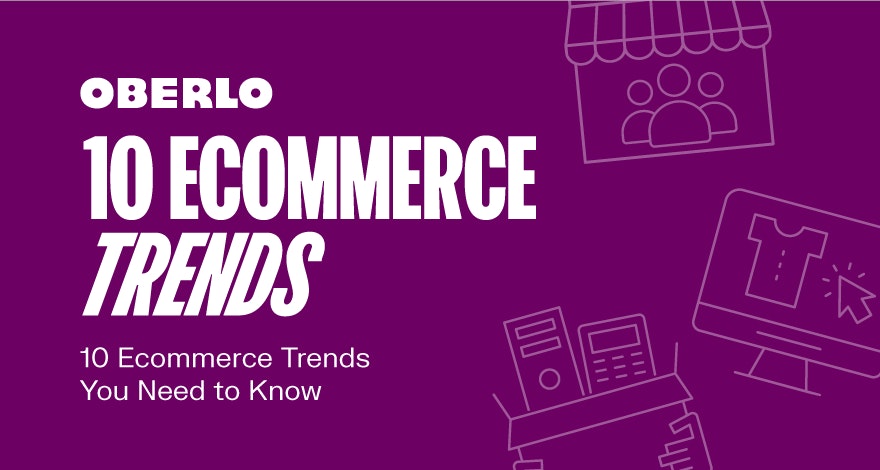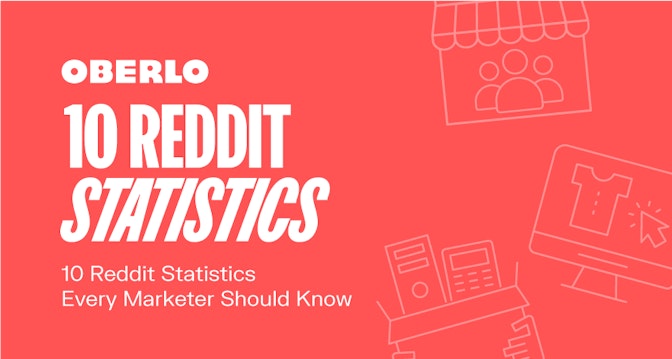In 1995, the first-ever online Amazon order was placed—a book.
Twenty-seven years later, the ecommerce industry has made more than $5.5 trillion in sales worldwide.
Ecommerce has revolutionized retail. It has evolved to meet the changing needs of people and to make online shopping easier for modern-day consumers.
When it started, ecommerce was fairly limited in its capabilities. But not anymore. Whether it’s customization, enhanced return policies, or improved integration, all of these changes (among countless others) have taken the world of ecommerce by storm.
And 2024 will only further transform the world of ecommerce.
So, if you’re still on the fence about the future of ecommerce, these latest trends will prove to you that ecommerce isn’t just rapidly growing, it’s here to stay. And you too can include these ecommerce developments in your business to ensure steady growth of your online store.
To take your ecommerce business to the next level in 2024, make sure to take advantage of these emerging industry trends.



Why Are Ecommerce Trends So Important?
The ecommerce world is increasingly competitive.
To stay ahead of the competition, trends need to be constantly monitored.
→ Click Here to Launch Your Online Business with Shopify
No matter how mature your ecommerce store is right now, if you don’t keep up with ecommerce trends, you’ll risk falling drastically behind.
You need to keep looking ahead to ensure future success. As we look ahead to 2024, you need to know these trends in order to take advantage of them.
That’s why it’s so important that ecommerce trends are analyzed and adopted in a timely manner. By doing this you can drive your ecommerce brand forward, and stay ahead of your competition.
Top Ecommerce Trends for 2024
Are you wondering what the future of ecommerce looks like? Do you want to look into what trends will shape your customer experience? Here are the 10 biggest ecommerce trends for 2024 that you need to look out for.
1. Consumers Hit the Gas Pedal on Online Shopping
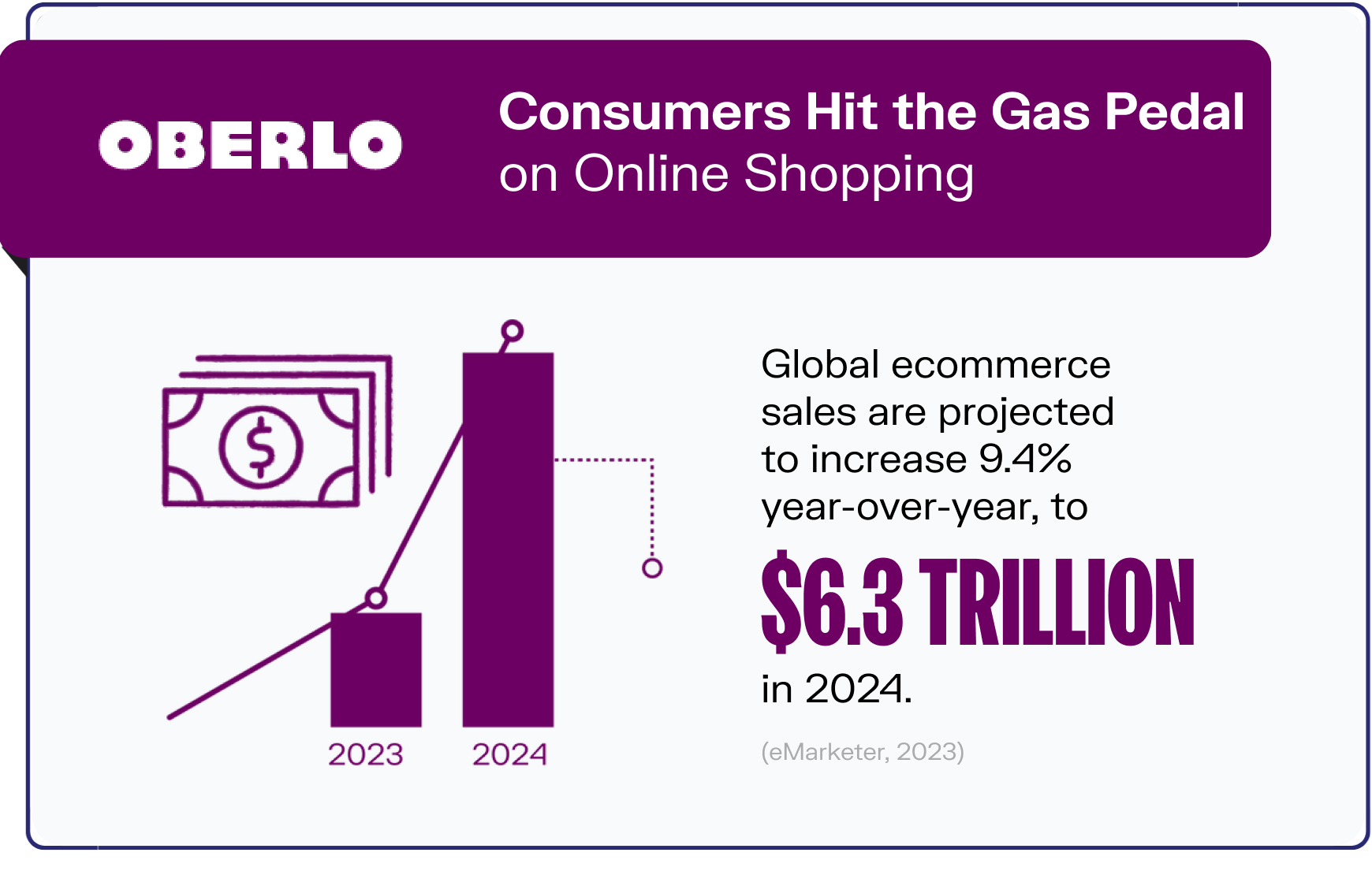
Ecommerce sales have been growing constantly and for good reason. Online shopping is one of the most popular online activities. Global ecommerce sales are projected to increase 9.4% year-over-year, to $6.3 trillion in 2024 (eMarketer, 2023).
That’s not all. Online sales are expected to continue growing and hit $8 trillion by 2027—around 38.9% more than that of the total ecommerce sales in 2023.
Even though online shopping is one of the most popular online activities, its usage varies by region. With the increasing popularity of ecommerce stores, a rising number of people are turning to online shopping.
This increase in online shopping can be attributed to several factors. One of the main ones is arguably the level of comfort provided to online shoppers.
There is also an increase in trust that online buyers have when they are purchasing online, as well as an improved website experience. At one point, people used to be hesitant to buy things online, but that’s no longer the case. Websites have also become a lot more customer-friendly.
With all the comfort that is provided, there’s no surprise that online sales growth is becoming unstoppable.
2. Ecommerce Strengthens in Digitally Mature Markets
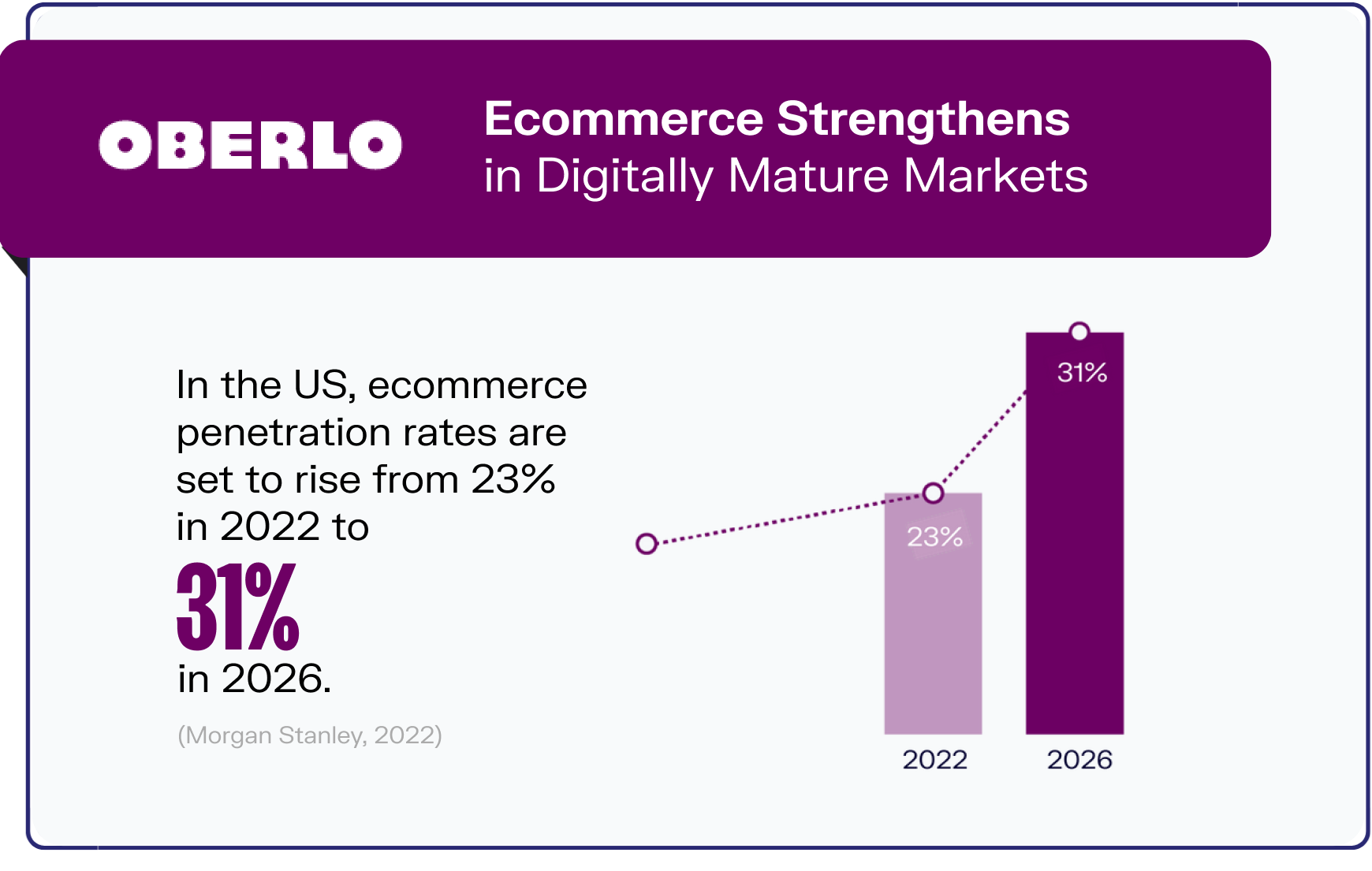
Undeniably, one of the biggest impacts—if not the biggest—on ecommerce trends in recent years is the COVID-19 pandemic.
With governments worldwide shutting stores and implementing lockdowns to restrict social movement for months on end in a bid to combat the coronavirus, more and more people resorted to online shopping to purchase items.
Experts predict that the impact of the coronavirus will not just be a short-term boost to ecommerce but one that’s here to stay, even after COVID-19. This is because people will get comfortable with the comfort and convenience it offers and the benefits of contactless payments, both of which are likely to cause a permanent behavioral shift toward digital purchases.
In fact, market analysts say the ecommerce industry will be the biggest beneficiary of the coronavirus pandemic. Global penetration rates, which are currently at 22%, are expected to increase to 27% by 2026.
Analysts are even expecting ecommerce adoption to increase in countries where online shopping is already pretty rampant. In the US, ecommerce penetration rates are set to rise from the current 23% to 31% by 2026.
3. Mobile Shopping Accelerates
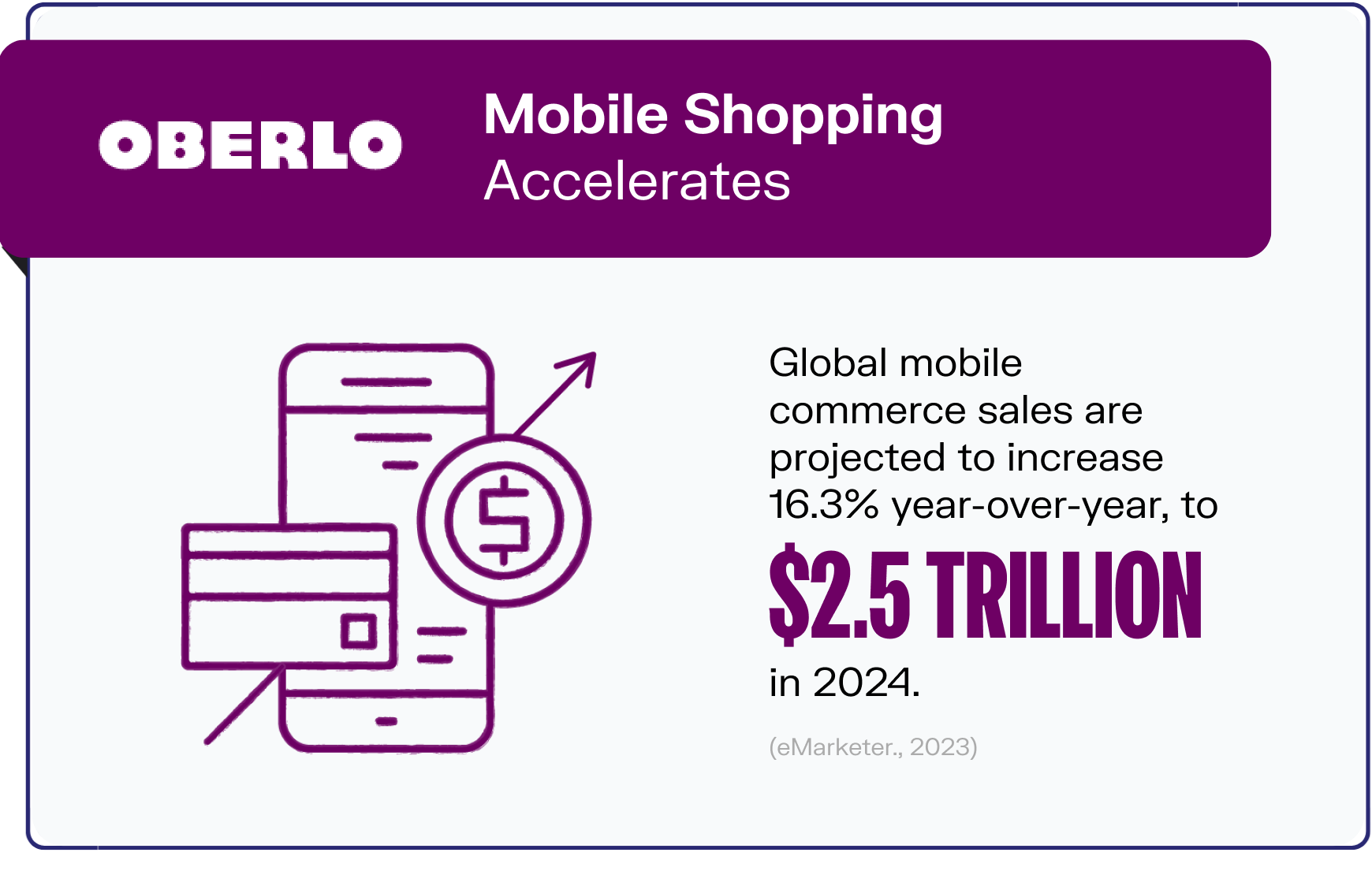
The growth of mobile commerce has been particularly noteworthy. In 2018, total sales made via mobile devices came in at $982 billion (Statista, 2023). This figure is expected to more than double to reach $2.5 trillion in 2024, accounting for 60% of retail ecommerce sales. By 2027, mobile commerce sales are projected to hit $3.4 trillion.
These figures can’t be ignored. Improving the ecommerce experience for mobile customers can be a huge opportunity for businesses to tap into.
Ecommerce growth has been driven in part by the increase in usage of mobile devices. That’s because consumers aren’t just checking out online, they’re also using their mobile devices to browse or research before making their minds up about their purchase.
As trust in online shopping increases, consumers start to feel more comfortable shopping on mobile devices than ever before. This is especially so with millennials and Gen Z consumers, who have grown up surrounded by computers and the internet. These generations are also more likely to be shopping online using their mobile devices in comparison to older generations.
With more and more sites now optimized for mobile use, make sure that not only your website but your online store is optimized for mobile devices as well. By doing this, you’re making ecommerce simpler and more accessible for a larger audience.
4. Young Consumers Change the Business Landscape
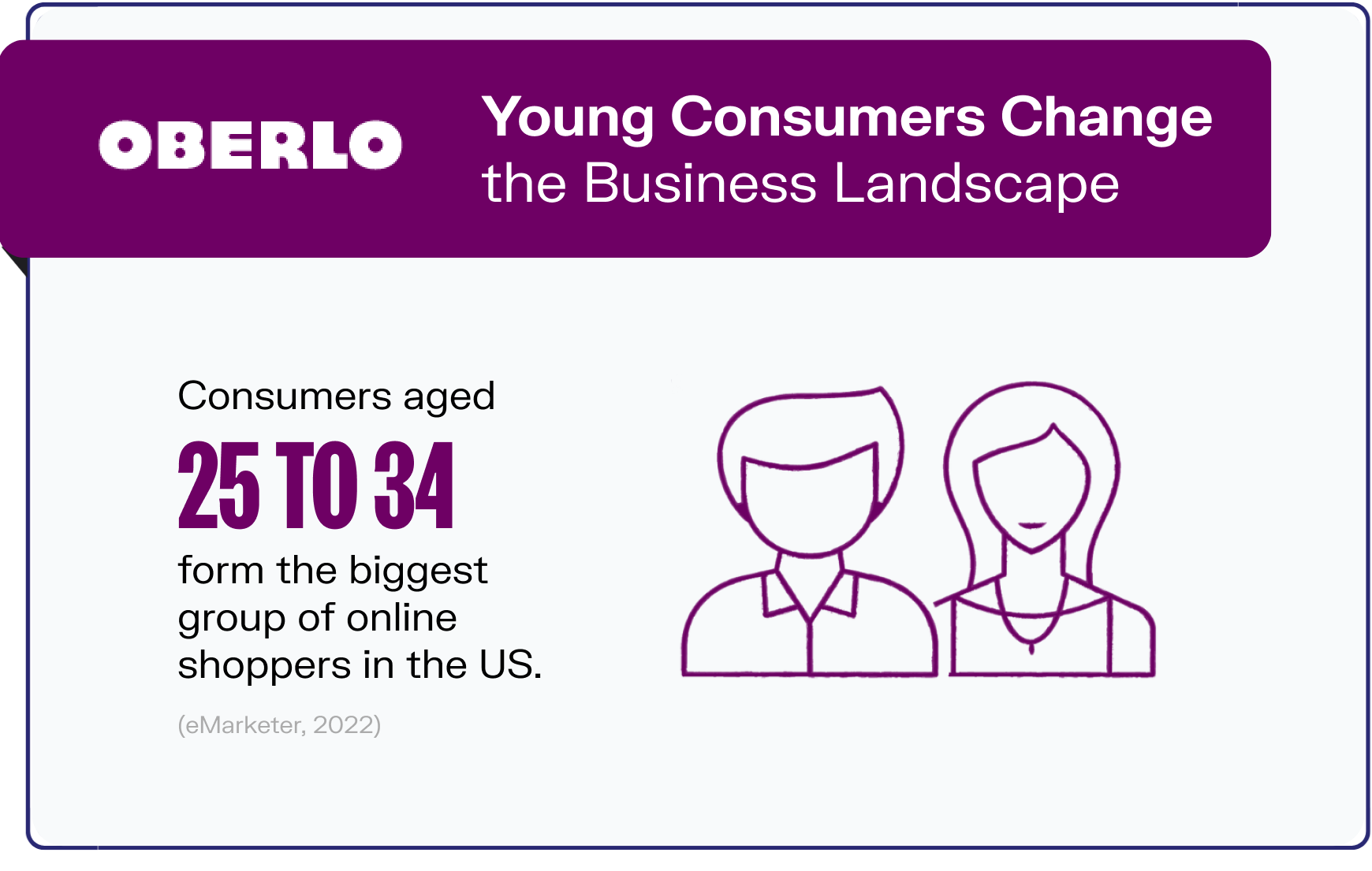
In recent years, a shift to online shopping has been observed across consumers of all ages. However, there’s one particular group that increasingly purchases stuff on the internet: young consumers.
Survey results show that the younger generation, particularly those aged 25 to 34, form the biggest group of online shoppers in the US, totaling 41.8 million people (eMarketer, 2022).
Saving money and finding deals was the key reason for young consumers’ online shopping, but they also appreciate a smooth checkout process and product recommendations given by businesses.
That said, going forward, as an ecommerce business owner, you should be targeting the younger generation to increase your sales potential. To do so, consider increasing your social media marketing efforts. More than half of young consumers who buy from independent brands discover them via social media—more than any other age group.
5. The Evolving Role of Social Media in Ecommerce
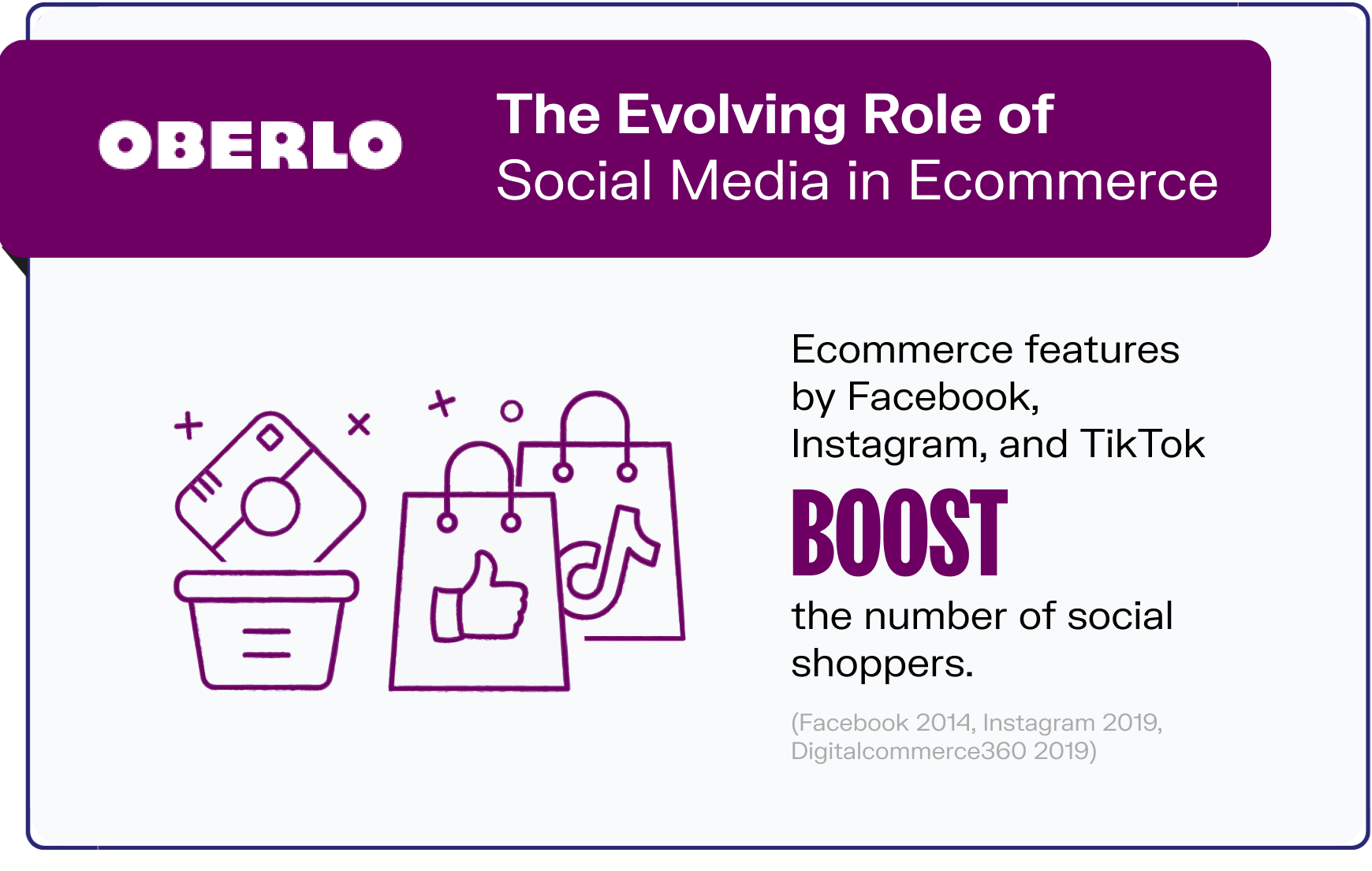
The number of social shoppers is also rapidly increasing. With the introduction of the Buy button on Facebook and Instagram Checkout, social media is playing a significant role in the world of ecommerce.
Social media has changed the way we live our daily lives, including the way we buy things. This is a great opportunity for brands to start thinking about how to improve their position on social media, which is a great platform for brands to get discovered.
With consumers spending more time on different types of social media, ecommerce businesses can get help from Instagram influencers to increase their chances of getting discovered by their target audience.
Additionally, with platforms like Shopify, businesses can easily link their ecommerce stores to social media sites so people can buy from them directly through social media. Instagram and Facebook, for example, are constantly updating their features to meet the comfort needs of online buyers.
And who can forget TikTok—the latest and rising rave within the world of social media that has not only made its way into the hearts of teens but also around Hollywood?
The video-sharing app has been working on incorporating ecommerce elements, and one of its latest efforts includes Shoppable Ads. These ads will help brands reach TikTok audiences who are most likely to convert with fully automated creatives and smarter, more advanced targeting. Moreover, TikTok has other commerce features that let store owners sell directly on the app.
These social media platforms act as channels for inspiration and allow brands an opportunity to be discovered while people scroll through their feeds. As social media continues to become a regular part of our daily lives, its power to influence ecommerce trends will only increase. That’s why brands need to adopt a shopping-focused approach to their social media strategy.
6. Environmental Topics Influence Buyers
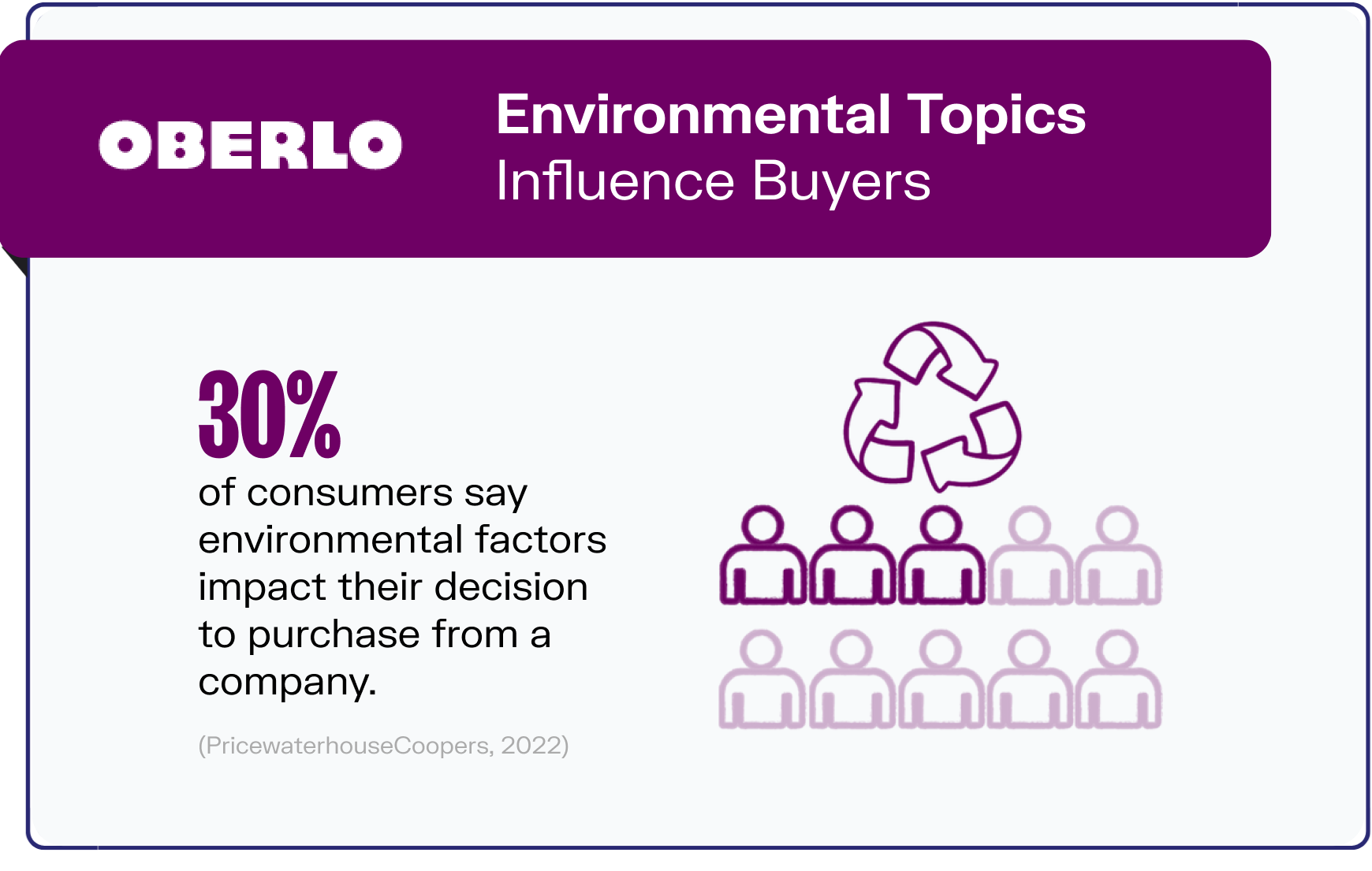
Green consumerism is on the rise, and brands need to take action. As many as three in 10 consumers say environmental factors impact their decision to purchase from a company.
As an ecommerce business, you should strive to create more sustainable practices. Consumers these days have become more conscious of the environment than ever before, and for the right reasons.
Online businesses need to step in and make sure their practices are environmentally friendly. This includes practices of sourcing products from fair-trade organizations to help create a greener ecommerce environment.
Millennials are paving the way forward to greener consumerism habits. Whether it’s free-range meat or vegan skin care products, there is an increasing demand for brands to start taking care of our environment.
7. The Desire to Shop With Aligned Businesses
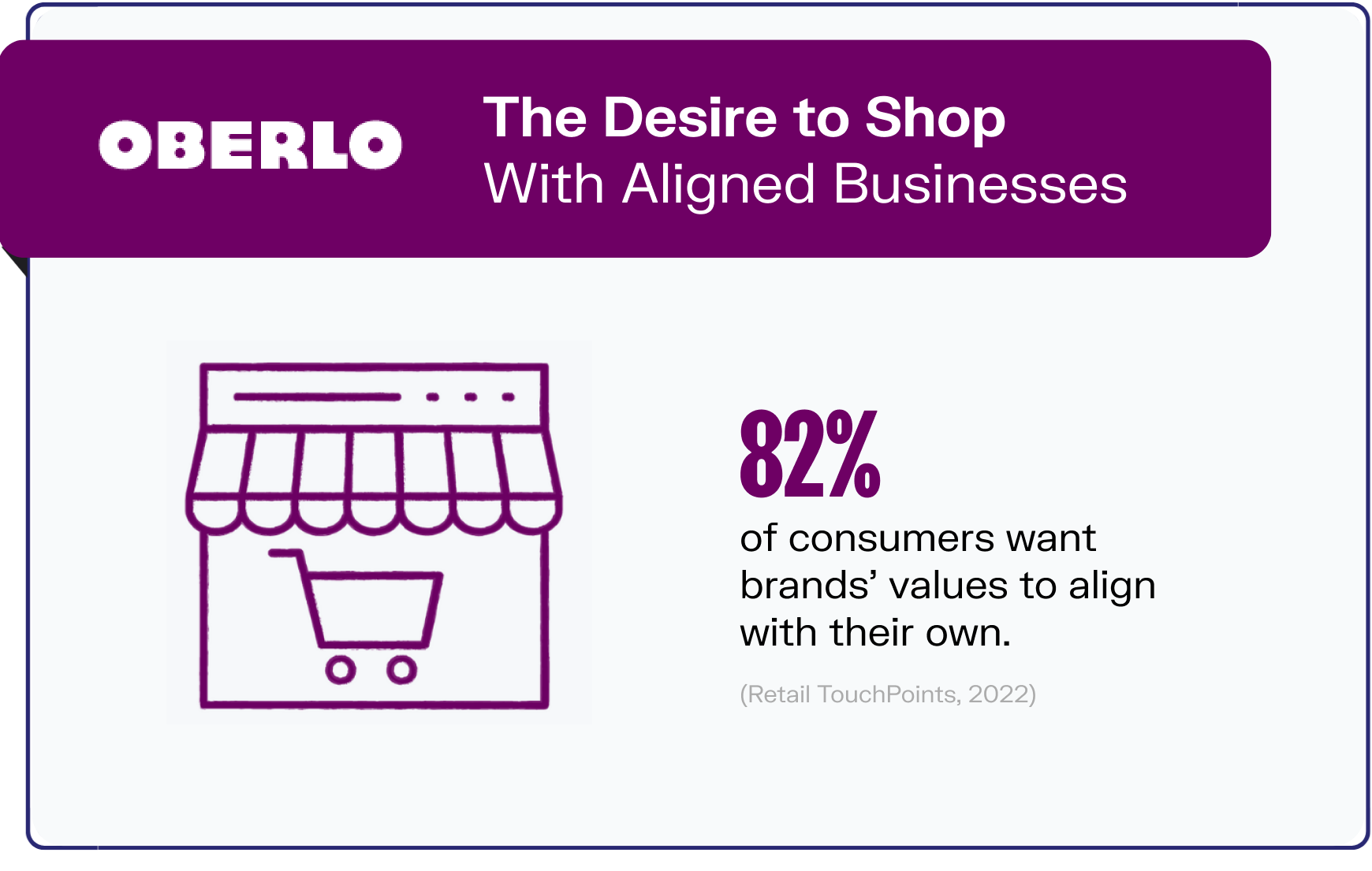
Not only are more and more consumers shopping online, but their shopping habits and brand preferences have also evolved.
The focus on sustainability and environmental practices aside, many consumers are interested in brands’ values—82% of consumers want these values to align with their own.
Moreover, they are clearly willing to act on this sentiment, with three-quarters of surveyed consumers sharing they had left a brand over a conflict in values.
So if you want to delight and retain customers, familiarize yourself with their values and then see how you can position your brand to align with them.
8. Virtual Reality (VR) Transforms How We Shop
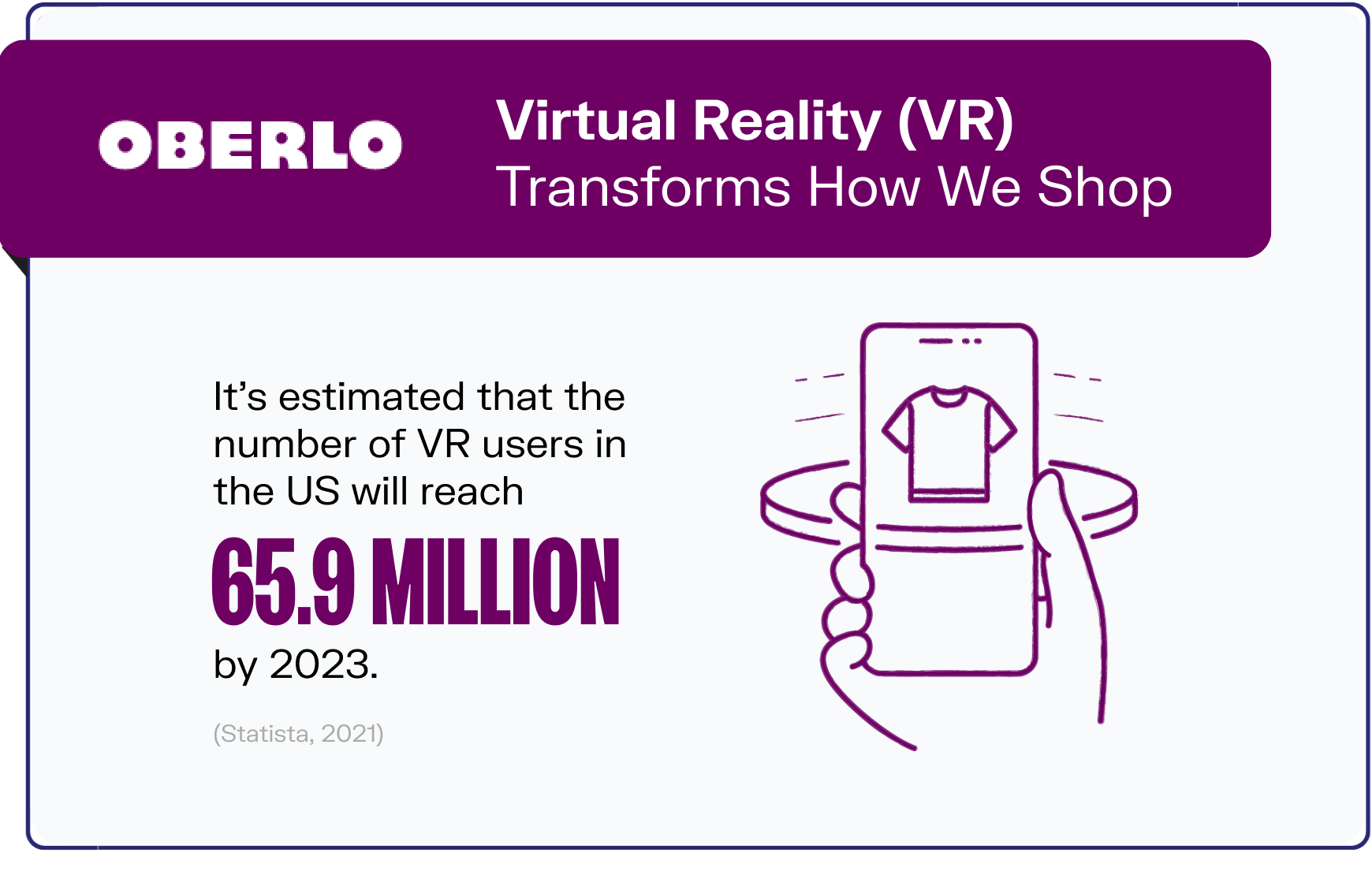
It’s estimated that the number of VR users in the US will reach 65.9 million by 2023. VR adoption among consumers will be driven by creative and innovative ecommerce storefronts. One of the main concerns people have when shopping online is the inability to see a product firsthand. VR technology helps bridge this gap and enables online shoppers to better visualize the products they are interested in.
For ecommerce businesses, this could be a game changer. VR/AR experiences can change the way online customers perceive the products they intend to buy. By showcasing your products in virtual reality, you can help them better understand if the items meet their demands.
Some ecommerce brands have already started to experiment with VR/AR, which will help them stand out from the competition. Delivering more personalized shopping experiences will result in better brand recall.
Companies are using virtual reality not only to enhance the customer experience but also to allow shoppers the ability to test and explore products in the way that they would do during an in-person shopping experience.
9. Personalization Is the Future
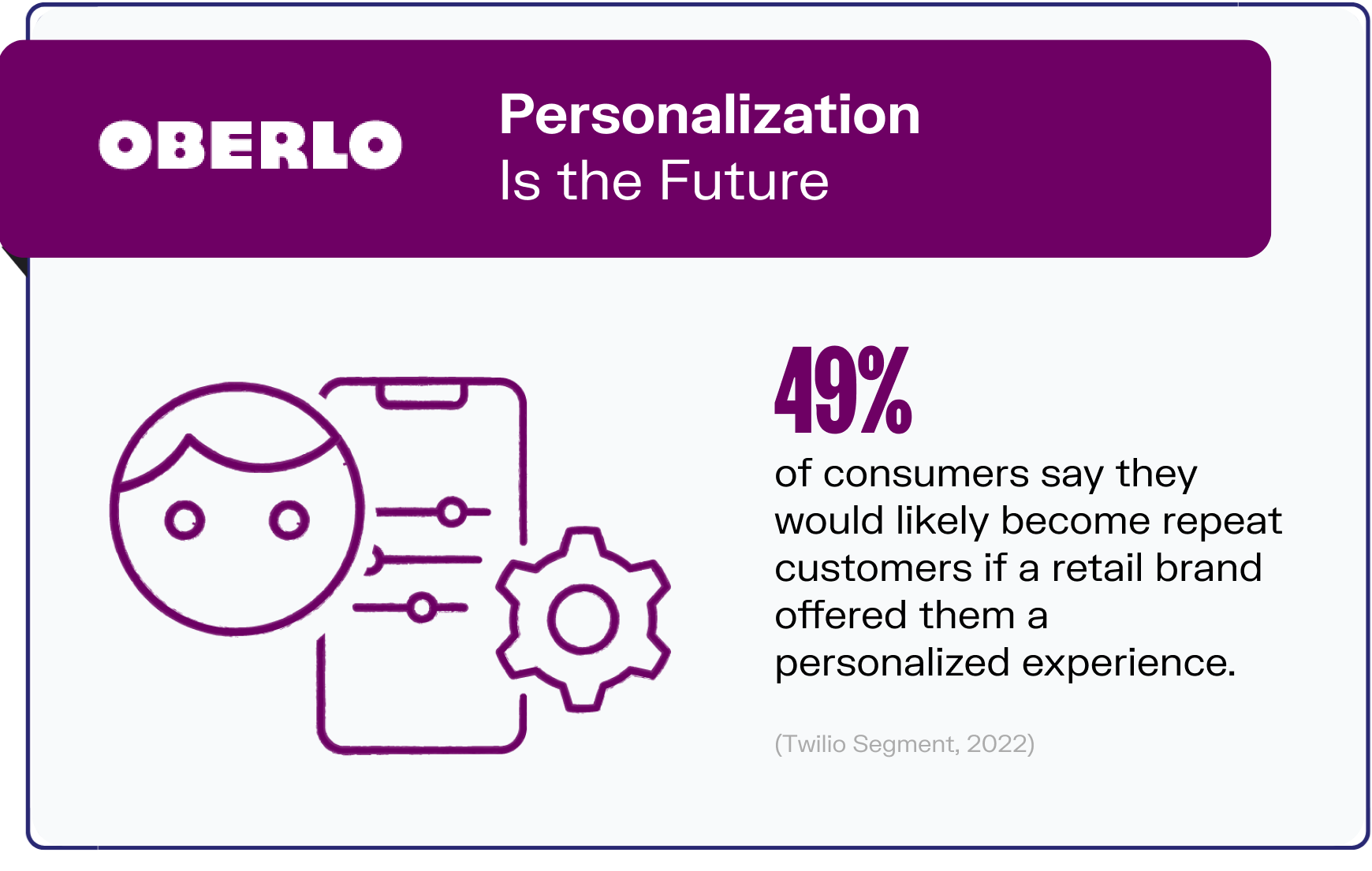
Personalized shopping experiences can keep customers around and make them loyal to your brand. Consumers even indicate they want such experiences, with 49% saying they would likely become repeat customers if a retail brand offered them a personalized experience.
Ecommerce sites are on board with this trend and are investing in website personalization tactics to make the online shopping experience a better one. This could include the ecommerce personalization of messages that go out via email, or by providing the right information to the interested consumer group.
By offering personalized customer communications, providing relevant discounts, and engaging with customers through, for instance, video content, you will deliver a better shopping experience and boost customer loyalty.
10. Visual Commerce Is on the Rise
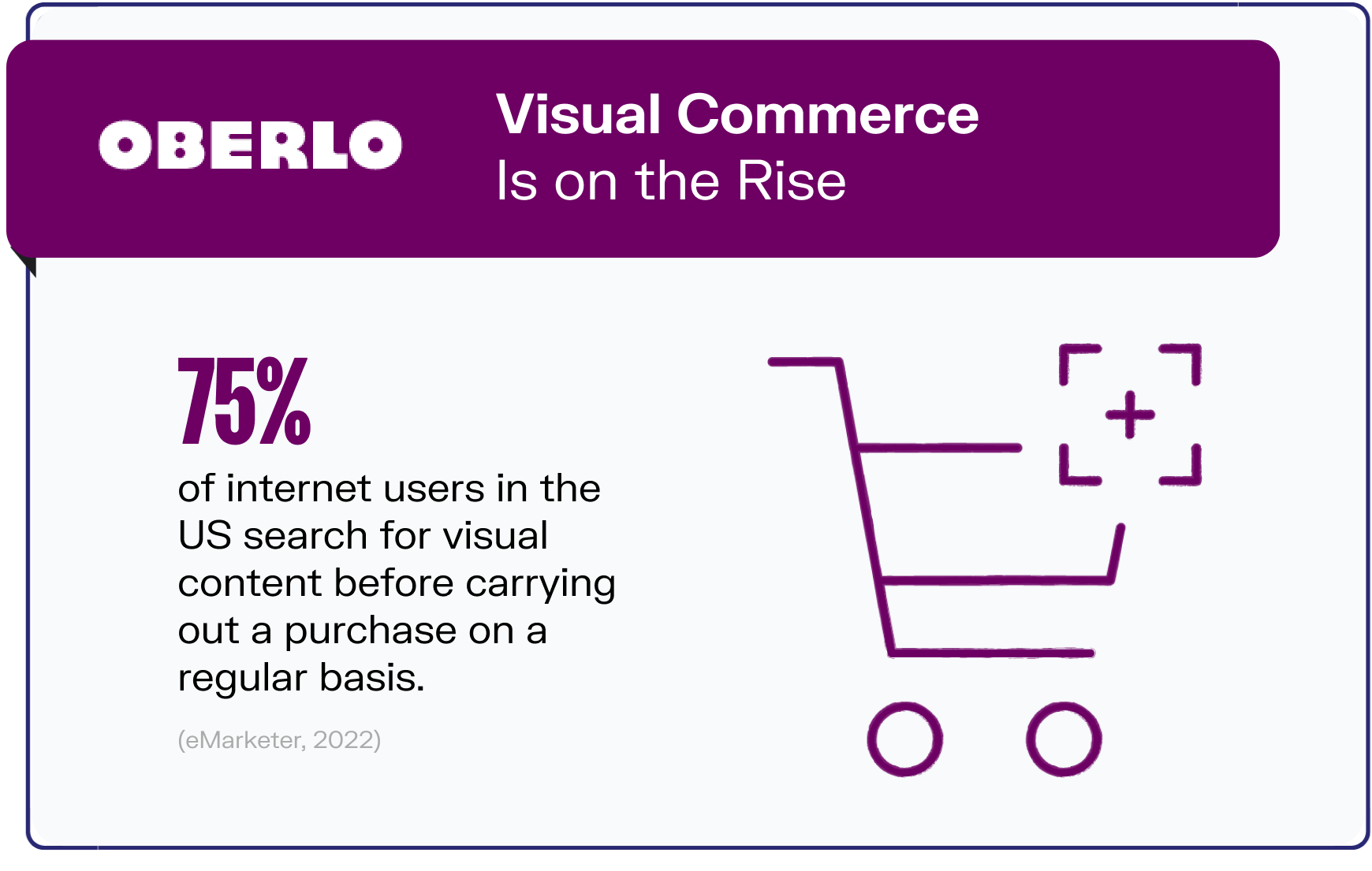
One of the many difficulties of running an ecommerce store is having to sell your product to consumers who have no chance of physical interaction with your product. That’s where visual commerce comes into play.
In short, visual commerce is the next generation of normal static visuals. It takes marketing to a whole other level, as instead of simply using product photos to market your business, it incorporates other types of visuals, such as consumer-generated media, interactive content, engaging videos, and, as previously mentioned, augmented reality.
As it stands, approximately 75% of internet users in the US search for visual content before carrying out a purchase on a regular basis. Only a handful (3%) do not.
Planning Your Ecommerce Strategy for 2024
With the advancement in technology and changes in consumer behavior, you need to keep an eye out for these ecommerce trends in 2024.
Whichever ecommerce trend you decide to adopt, do it to improve the shopping experience for your customers and build a long-lasting relationship with them.
Take your ecommerce evolution to the next level by evolving with it side-by-side and taking advantage of these ecommerce trends.




Summary: Ecommerce Trends
Here’s a summary of the ecommerce trends you need to know in 2024:
- Global ecommerce sales are projected to increase 9.4% year-over-year, to $6.3 trillion in 2024.
- In the US, ecommerce penetration rates are set to rise from 23% in 2022 to 31% in 2026.
- Global mobile commerce sales are expected to increase 16.3% year-over-year, to $2.5 trillion in 2024.
- Consumers aged 25 to 34 form the biggest group of online shoppers in the US.
- Ecommerce features by Facebook, Instagram, and TikTok boost the number of social shoppers.
- 30% of consumers say environmental factors impact their decision to purchase from a company.
- 82% of consumers want brands’ values to align with their own.
- It’s estimated that the number of VR users in the US will reach 65.9 million by 2023.
- 49% of consumers say they would likely become repeat customers if a retail brand offered them a personalized experience.
- 75% of internet users in the US search for visual content before carrying out a purchase on a regular basis.
Want to Learn More?
Are you excited about these ecommerce trends in 20224? Or uncertain? Let us know in the comments below!
